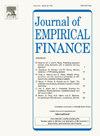为什么Cochrane-Piazzesi模型可以预测国债收益率?
IF 2.4
2区 经济学
Q2 BUSINESS, FINANCE
引用次数: 0
摘要
我们解释了为什么Cochrane-Piazzesi (CP)模型在预测债券超额回报方面如此有效,该模型使用了一个单一的帐篷形远期利率线性组合。通过使用一种新颖的统计检验和流行的重采样技术,首先我们排除了高可预测性可能是样本内过拟合的人工产物的可能性。然后我们发现,与原CP论文中提出的解释相反,因子负荷的特定帐篷形状和4 - 5年收益率差对模型的预测能力都不是必不可少的。相反,我们的分析表明,CP模型的预测能力在于它能够识别产生超额收益平稳过程所需的准单位根正向利率回归量之间的协整关系。为了支持这一解释,我们表明远期利率之间的协整关系直接提供了超额回报的强预测因子,并且我们提出吸引力的协整模式至少产生了部分超额回报。我们的研究结果揭示了CP因子捕获的债券收益可预测性的来源,并强调了协整属性与收益率动态之间的联系本文章由计算机程序翻译,如有差异,请以英文原文为准。
Why does the Cochrane–Piazzesi model predict treasury returns?
We explain why the Cochrane–Piazzesi (CP) model, which uses a single tent-shaped linear combination of forward rates, is so effective at predicting bond excess returns. By using a novel statistical test coupled with a popular resampling technique, first we rule out the possibility that the high predictability may be an artefact of in-sample overfitting. Then we find that, contrary to explanations proposed in the original CP paper, neither the specific tent shape of the factor loadings nor the four-to-five-year yield spread are essential for the model’s predictive power. Instead, our analysis suggests that the predictive power of the CP model lies in its ability to identify the cointegration relationship among the quasi-unit-root forward rate regressors needed to produce the stationary process of excess returns. To support this interpretation we show that cointegration relationships among forward rates directly provide strong predictors of excess returns, and we propose that the cointegration modes of attraction generate at least part of the excess returns. Our findings shed new light on the source of bond return predictability captured by the CP factor and highlight the link between cointegration properties and the dynamics of yields.1
求助全文
通过发布文献求助,成功后即可免费获取论文全文。
去求助
来源期刊

Journal of Empirical Finance
Multiple-
CiteScore
3.40
自引率
3.80%
发文量
59
期刊介绍:
The Journal of Empirical Finance is a financial economics journal whose aim is to publish high quality articles in empirical finance. Empirical finance is interpreted broadly to include any type of empirical work in financial economics, financial econometrics, and also theoretical work with clear empirical implications, even when there is no empirical analysis. The Journal welcomes articles in all fields of finance, such as asset pricing, corporate finance, financial econometrics, banking, international finance, microstructure, behavioural finance, etc. The Editorial Team is willing to take risks on innovative research, controversial papers, and unusual approaches. We are also particularly interested in work produced by young scholars. The composition of the editorial board reflects such goals.
 求助内容:
求助内容: 应助结果提醒方式:
应助结果提醒方式:


